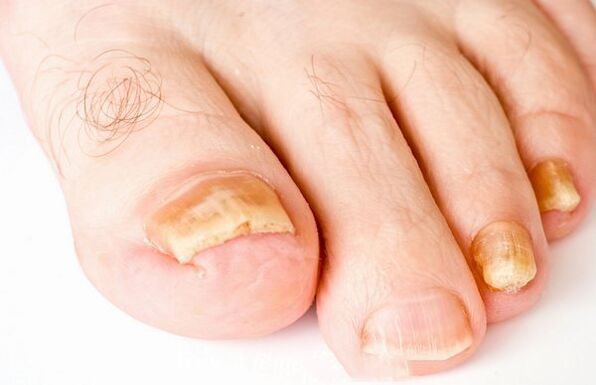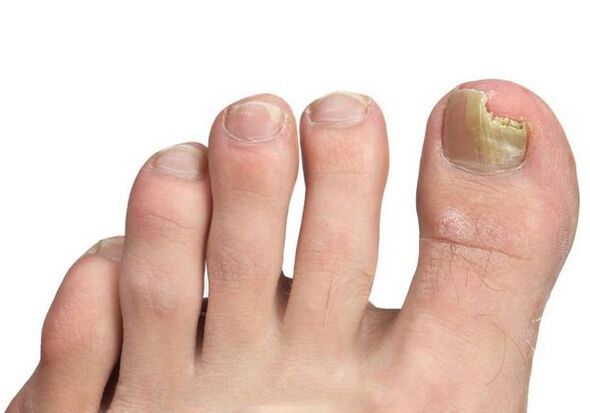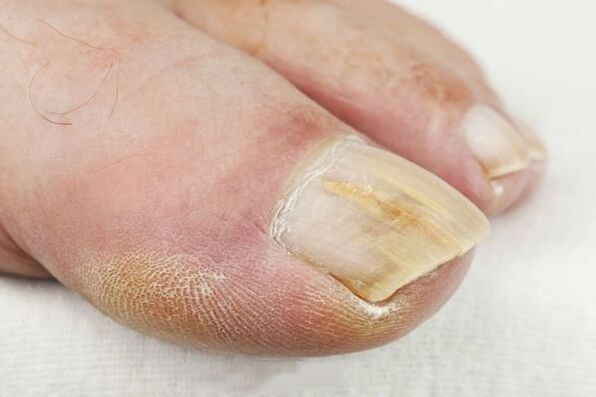Hello, dear readers.Onychomycosis is a medical name for a very common disease, better known to us as a nail fungus.Recently, a jump in the level of incidence of this ailment has been observed.This unpleasant fact is associated with the popularity of cheap shoes, which is not particularly quality.It is made of low -grade materials that have low throughput for air, which prevents normal ventilation of the foot.In such conditions, with the sweating of the feet, ideal conditions are created for the productive activity of pathogenic microflora.This problem is widespread.Its scope is so large that the number of cases exceeds 20% of all the inhabitants of the planet!
As the name implies, the nail fungus is a mycotic (fungal) damage to the nail plate.There are a lot of varieties of pathogenic fungi that can cause this disease.
But, according to doctors, in most cases, the nail plates on the legs are affected by dermatophytes.Significantly less often the cause of the development of the disease is yeast (candidiasis) and mold fungi.
Sometimes in practice you have to deal with deformation of nails on the legs of a black nature.
Symptoms of nail fungus - the first signs
The fungal damage can affect not only the nails, but also the feet themselves.Symptoms in infection will differ depending on the variety of the pathogen that caused the development of the disease.The degree of damage to the nail plate also has a value.
But, despite the existing differences, the general signs of fungal activity can be distinguished:
- Changing the color of the nail.
- The appearance of spots on the nail plate, stripes, thickenings, influxes.
- Loosening the structure of the nails or their stratification.
- Redness, peeling, cracking of the skin of the feet.
- The appearance of itching, pain (including only when walking), burning in the area of damage.
- Inflammation, dryness of the affected areas of the skin.
- Often the feet exude a repulsive aroma.
A whitish plaque can be observed on the bottom of the feet.Peeling of the skin is replaced by the appearance of small flakes of dead skin, which cover its surface.
Types of fungal lesions
Normotrophic form of damage.White or yellowish spots or strips appear on the nails.As the disease progresses, they spread, gradually completely changing the color of the entire plate.
The thickness, as well as the gloss of its surface remains unchanged.There may be a violation of the fusion of the nail with submarine fabrics, which is why it exfoliates and can be easily and painlessly removed.

Hypertrophic form of the disease.The affected nail becomes brownish-yellow or gray.A thickening of the nail plate is observed due to the growth of the submarine epithelium.The nail plate itself becomes a crumb.
The lateral parts are especially destroyed, because of this it acquires a claw-like shape.This is a characteristic sign of this disease.The nail surface becomes dull.When walking, a sick person experiences pain.
Atrophic form of damage. The nail plate changes color, becoming brown-gray, loses its transparency and shine.The nail begins to gradually collapse, starting from the outer part in the direction of the nail growth zone.
Growing epithelial particles fill the nail bed with loose mass.Without treatment, a complete loss of nail will occur.
Classification by pathogen of the disease
Dermatophytic lesion.It occurs in the vast majority of cases (about 90%).There are several varieties.With some, infection can apply to intercal areas on the foot, to the skin of the legs and even hands.
Yeast defeat.This variety can be difficult to identify, especially at the initial stage.The nail roller is first affected, it inflams and swells.Later, peeling in this area is noticeable, light itching and weak soreness can be possible.The nail becomes tuberous, loses its shine, can crumble.In advanced cases, purulent discharge appears.
Planeal defeat.Under the influence of mold, the nail changes, acquiring a greenish, bluish tint, or begins to blacken.
Its side parts become rough.Over time, the affected areas die, which is why the nail is deformed.Gradually, he will collapse.
Planeal defeat is quite rare, mainly as a complication of a different form of fungal lesions, as well as with HIV infection.
Classification by the location of the lesion
The fungal damage can be localized in different parts of the nail.In this regard, several types of damage are distinguished in the international classification.
- Total when the effect of the fungus covers the entire nail.
- Distant, if only the upper part of the nail (free edge) is hurt.
- Proximal, in which there is a damage to the nail roller (lower part of the nail plate).
- Lateral, observed on the side parts of the nails.
Often they characterize different stages of the disease.
The lesion of the fungus of the feet
There are several varieties of fungal damage to the foot.
Interdalz form. The most common type of foot fungus.As the name can be seen, the disease affects interdigital gaps, later it can also switch to other parts of the feet, including nails.
In interdigital folds, moist cracks and specific skin layers first appear.Later, skin erosion is noticeable.The disease has a tendency to develop into chronic.Often complicated by streptococcal infection
Hyperkeratic (squamous) form.Touches the entire foot.It differs in a rather deep defeat of tissues.At first, the skin peels off and blushes slightly, then it becomes rough and eager, on the heels there is sometimes a deep cracking of the keratinized layer.
The disease can spread to the nails, which at the same time thicken, darken and begin to paint.The disease is very characteristic of athletes.
Dyshidrotic (vesicular) form. Vesicula (bubbles with liquid) appear on the feet, which, after breaking through, leave erosion traces.The skin becomes ulcerated, with peeling areas, covered with purulent crusts.It is often accompanied by an allergic rash (due to the action of toxins).
The disease is infrequent and treated quite easily.But here the danger lies in the high probability of lesions of bacteria or viruses, which significantly complicates the course of the disease and actually excludes the possibility of rapid recovery.
Erased form.It is not easy to identify, since changes in the skin and condition of the nails are weak.Nail plates can become yellowish.The skin on the sole is slightly peeling, becomes loose.Itching may be observed.The disease is well lend itself to cure.
Nail fungus - the causes of the appearance
Symptoms of nail fungus and the first signs that signal the general level of immune resistance of the body and improper care of the feet.

If protective functions are normal, then even when infected, the disease will not be able to develop.Immune mechanisms will cope with the aggressor on their own.
But when the immunity is weakened in conjunction with related causes favorable the development of the disease, the body will not be able to resist the fungus.
For an effective struggle with it, you need to try to eliminate or at least minimize (for example, chronic diseases are unlikely to be completely overcome) the influence of these factors.
The reasons for the development of the fungus:
- Excessive sweating of the legs.
- Violation of natural ventilation of the feet (dense shoes made of low -quality material, synthetic socks).
- Reducing the body protection functions.
- Violation of the protective layer of the skin (excess hygiene, excessive treatment with antibacterial agents, abuse of fluid to relieve varnish).
- Injury to the nail plate and damage to the sole of the legs (cracks, corns, etc.).
- Features of the foot that worsen its aeration (due to flat feet, obesity, etc.).
- Concomitant diseases (diabetes, varicose veins, psoriasis, metabolic disorders, digestion, blood circulation in the legs, HIV).
- Antibiotics and some other drugs taken by a long course.
- Low level of foot hygiene.
- Age and sexual criteria (men and elderly people are more susceptible to disease).
- A professional factor (conditions with high temperature and humidity, dustiness, ionizing radiation, wearing rubber shoes; masseurs, orthopedists, sanatorium workers, steamers, etc.) also often get sick.
- A visit to public saunas, baths, swimming pools.
- Salon pedicure in violation of the principles of hygiene and sterility.
- Household factor (overall use of washcloths, slippers, mat in the bathroom, etc.).
As studies have shown, people who suffer from diabetes are most affected by the fungus of the foot and nails.This disease is observed in 35% of diabetics.
The probability of getting fungal damage to psoriasis is also high.Here the probability of getting higher by 55%.
The consequences of fungal lesions

Although the foot fungus does not pose a direct threat to the patient’s life, you cannot relate to your health irresponsibly and let everything go by itself.
The fungal damage is not at all an annoying nuisance and an exceptionally aesthetic problem.
Timely inconsistency of the disease leads to the development of a chronic form of ailment with regular exacerbations.
Surprising complications are also possible.
- Violation of the process of nail growth, growing into soft tissue.
- Complete or partial loss of nail.
- Stagnant phenomena, including lymphostasis.
- Distribution of the disease to neighboring areas and deep into tissues.
- Connecting other infections (bacterial, viral and fungal).
- Elevated inflammation is an acute inflammatory infectious disease.
- The diabetic foot in diabetics is anatomical changes, leading to an increase in the likelihood of injury, infection, suppuration and necrosis (necrosis) of tissues.
- Elephantiasis is a pathological growth of skin and subcutaneous tissues, leading to an increase in the size of the organ.
- Eczema.
Treatment of nail fungus - inexpensive and effective drugs
To prescribe the correct treatment regimen, you need to make an accurate diagnosis.For this purpose, a number of laboratory tests are carried out.Modern pharmacology offers a great many different antifungal drugs.
That is why independent treatment is difficult and often turns out to be ineffective.The doctor will have to find out the pathogen, the degree of neglect of the disease, the area of damage, the presence of concomitant diseases.
Only based on the complex of information received, he will be able to prescribe a course of therapy.Here, both local drugs are used (for external application - ointments, creams, varnishes, foams, serums), and general, taken inside (tablets, capsules).
The active substance in antifungal ointments can be cyclopirox, naphthyphin, nystatin.
If the lesions of the fungus are quite extensive, the use of tablet antimicotic drugs is recommended.
Unlike external funds, tablets have a general effect on the whole body of the patient.
Puriently prescribed drugs based on substances of terbinafine, fluconazole, itraconazole.Often there is a need for surgical removal of formations, but there are inexpensive and effective drugs from nail fungus.

Many of these funds are also indicated for preventive use.
It must be remembered that all antimycotic drugs have a different side effect.Therefore, treatment, prescription and cancellation of drugs, control of the patient's condition - all this is exclusively in the competence of the doctor.
Often, the recovery process can be very protracted, until a year, until the affected nail is completely updated.
During the treatment period, special attention should be paid to hygiene of the legs.With fungal nail damage, the use of decorative varnishes is not allowed.
To prevent infection of households, you can not walk barefoot at home, wearing only closed shoes is allowed.It needs to be treated twice a day with antifungal agents.After using the bath, its careful processing is carried out.
Joint washing of things is prohibited.After the cure, you need to get rid of all objects that have contacted with their feet (washcloths, slippers, all socks, etc.).
Recommendations
- The legs should be kept clean and dry.Wash the feet once a day, if necessary - more often.After that, their surface, including interdigital gaps, diligently dried.Now you need to wear only fresh socks.
- Shoes should be comfortable, not too old (no more than 3 years), from a breathable material.Poor or fashionable rubber models cannot be worn daily.At least, the duration of its wearing during the day should be limited.For this purpose, it is recommended to use a replaceable pair.It is extremely recommended to use other people's shoes, including slippers.
- Socks are used from cotton, wool or other non -intensive materials.It is permissible to wear synthetics only in some cases.
- The most difficult thing is to destroy the fungus on wooden surfaces.This should be taken into account when visiting public steamers, baths, pools.It is better to be in a closed rubber shoe.
- Socks, room shoes, insoles need to be regularly arranged.
- The procedure for salon pedicure should be carried out by a proven master subject to sterility rules.Or at home adhering to the same principles.It is necessary to avoid all kinds of injuries of nail plates in every possible way, timely eliminate the problems characteristic of the surface of the sole (callous forms, corns, cracks), do not abuse pedicure, degreasing and disinfectants.
Take care of yourself, follow your health.Be healthy!
















